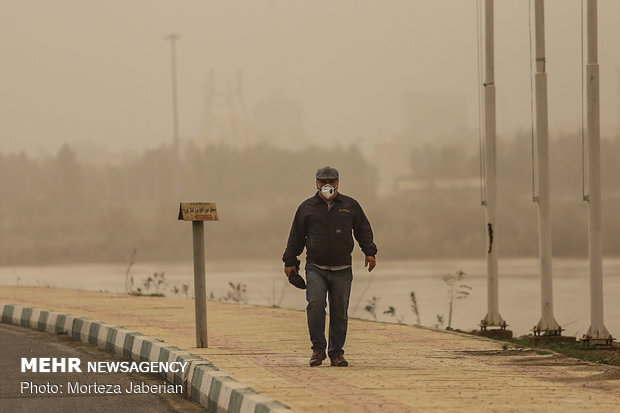Iran surrounded by 270m ha of SDS hotspots

TEHRAN – Some 8 large sand and dust storm (SDS) hotspots stretching to 270 million hectares in neighboring and Persian Gulf countries are affecting Iran, Ali Mohammad Tahmasebi, head of the national working group for mitigating SDSs, has said.
A year and a half ago, a regional action plan was prepared, as well as two sub-regional action plans for managing SDS sources outside the country, and shared with the Ministry of Foreign Affairs to announce to the neighboring countries, he stated.
Considering that most of the dust-raising areas are located in Iraq and Syria hit Khuzestan province and some western parts of the country, a national specialized working group was formed to cooperate with these countries, Tahmasebi explained.
Out of 8 large SDS hotspots with an area of about 270 million hectares around Iran, five are located in neighboring and non-neighboring countries of the Persian Gulf, he said, adding, “Given the good diplomatic relations we have with some of these countries, it was decided to start work against this phenomenon with a tripartite agenda, including the countries of Iran, Iraq, and Syria.”
According to the working group, it was decided that environmental conventions, especially the United Nations Convention to Combat Desertification, should work together to address the problem, he further highlighted.
Negotiations were held with the UN Resident Representative in Iran Stefan Priesner to play their international role in dealing with the phenomenon, he noted, IRIB reported on Tuesday.
The SDSs phenomenon has been plaguing the country for several years and has caused problems in many provinces. According to experts, natural and human factors are involved in the occurrence and severity of this phenomenon which is mainly caused by excessive consumption of water and drying up reservoirs.
The internal dust sources are estimated at 34.6 million hectares, generating an average amount of 4.22 million tons of dust per year, about 1.460 million hectares are dried wetlands.
Some 4.23 million tons of dust are raised per year, which means the loss of soil fertility will hit the agricultural sector.
Moreover, 300 million hectares in the neighboring countries are giving rise to SDSs, which transport dust into Iran. The total dust density is estimated at about 150 million tons.
In fact, the dust is raised from Turkmenistan, Uzbekistan, Afghanistan, and Pakistan in the northeast as well as Iraq, Syria, Saudi Arabia, and Jordan in the south, southwest, and west.
On April 8, a dense mass of sand and dust storms entered Iran from Iraq and affected the western and central provinces, and eventually hit 25 provinces, including Tehran, Alborz, Kermanshah, Ilam, Zanjan, and Kordestan, causing the air pollution index of Tehran to reach a very dangerous scale.
Dariush Gol Alizadeh, Head of Iran's National Climate Change Office (NCCO) of the Department of Environment told IRNA on Tuesday that the hotspots of the dust haunting the country in the last few days in eastern Syria, western Iraq, as well as Jordan, and Saudi Arabia.
These dust sources have appeared many years ago, and due to the drought and water shortages that have occurred in recent years, they have both intensified and increased in number. In fact, abandoned agricultural lands in those countries are a source of SDSs, he explained.
At present, this phenomenon cannot be dealt with, but the damage can be minimized, he said, adding, programs to be carried out in this regard can be planting crops, shrubs, and finally soil stabilization by biological mulches.
In the past four years, about €370 million has been spent by the National Development Fund to combat SDSs, which had good results, but it seems that the annual credit is declining as conditions improve, Ali Mohammad Tahmasebi, head of the national working group for SDSs mitigation, said.
FB/MG
Leave a Comment